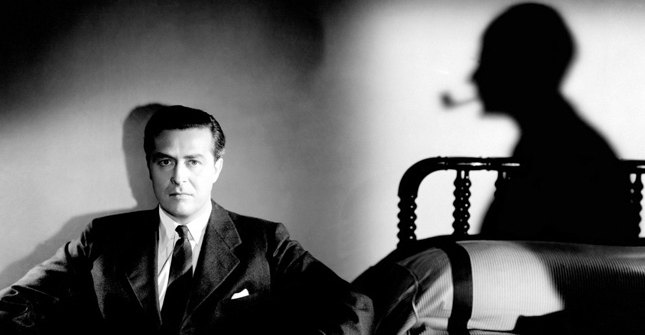Before “Halloween” there was “Black Christmas,” an early slasher entry that features all the conventions you’ve come to know and love (or hate): the isolated setting, the group of college-aged students (preferably girls), the voyeurism of a stalker-killer watching, and the methodical (well, at least in the killer’s mind) elimination game that he plays. Why, there’s even a hockey mask in this flick, though it’s worn by a goaltender in a game, and not some chainsaw- or knife-wielding psycho.
A few notable names pop up in this low-budget–under $700K Canadian–flick, among them John Saxon (who would later appear in another slasher pic, “Nightmare on Elm Street”), Olivia Hussey (who was a lot sexier in “Romeo and Juliet”), and Margot Kidder (who looks more like a housemom than sorority girl, and such a skanky lush that it’s hard to imagine her playing clean-cut Lois Lane opposite Christopher Reeve just four years later).
Aside from some interesting camerawork–including some POV roving angle shots with a hand-held camera that predate “Blair Witch Project” by 25 years–there’s nothing to really distinguish this film from hordes of others. Except, perhaps, the single image of the first victim we see throughout the film.
Director Bob Clark (“Children Shouldn’t Play with Dead Things,” “Dead of Night”) seems to have more fun with this than the audience, as he revels in creating an atmosphere of creepiness. Even the good guys are creepy. When, for example, we see a man waiting outside a college entrance, we don’t know if he’s the killer whose hands we just spotted scaling the trellis into the sorority house, the perv who keeps phoning the house to breathe heavily and talk dirty to the sisters, or a normal person. Whether that’s effective or affected will be a matter of viewer taste. A cat named Claude also factors into the mix, though it’s not black. It’s white–heavy irony.
So what happens is this: a perv keeps calling, people disappear, the police get into the act, and they try to track the caller and the killer. Suspects? Well, practically everyone, since practically everyone seems creepy or a little off-center in this film. Jess (Hussey) has a boyfriend who’s just a little weird and who makes threats to her if she goes ahead and aborts their baby. Barbie (Kidder) is a raving alcoholic who shows disdain for almost everyone. Then there’s Mrs. Mac (Marian Waldman), a closet tippler who comes and goes like a tenant and does nothing to really care for the girls she’s supposed to be house-mothering. Other boyfriends and would-be boyfriends also lurk rather than simply smile and knock on the door and go off on dates, as they would in any other movie or any other sorority house. No, everything here is cloaked in the same sort of gauze that hangs all over their Christmas tree (I mean, come on, who decorates their tree like that, except perhaps Elvira?).
Those who live for suspense will find a few moments, but not many. The minute the first girl (Lynne Griffin) announces she’s going upstairs to finish packing, you know she’s a goner. It’s the same with the second victim, whose fate is telegraphed as much as the first the instant she enters the room where you-know-who is hiding.
The one thing that writer Roy Moore manages to do that’s skillful is to delay the finding of the bodies so that there’s a gap between what the characters (and possible victims) know and what the audience knows. But that’s just not enough to compensate for a plodding narrative that tips its hand way too many times. The moments of terror are also so abbreviated that there’s hardly time to savor (or be repelled by) them.
As for the performances, when you look at what Kidder and Hussey have done with other roles, you wonder if the straight-faced prelude to terror is something that felt like a straitjacket on them, because they look and talk like B-Movie actresses here. And the quality? Cheap is cheap, but boy, is this film grainy and indistinct.
Video:
When I first popped this in my Blu-ray player I found myself wondering, Why? Why was this even released on Blu-ray, unless all the players in the world have suddenly become Blu and it’s the only way for catalog titles to see the light of day. But DVD still reigns supreme, and so it’s a marvel that a film with the master in such obviously poor shape would be a candidate for Hi-Def. This is the worst-looking title I’ve screened in Blu-ray. The graininess and fuzzy edges are so pronounced that it would be a 5 or 6 if it were a DVD. But as a Blu-ray? There’s been no apparent restoration, and the colors are faded, there’s no hint of 3-dimensionality, and the overall picture looks as rough as an old Fifties’ TV show played straight from the can. While there’s no real artifacting that’s the result of the AVC/MPEG-4 transfer, the source materials were clearly so rough that whatever the transfer, without major restoration and post-production clean-up this title was going to look pretty sad in 1080p. And it does. The aspect ratio isn’t listed, but it would appear to be 1.66:1, or else a 1.78:1 stretched to fit the entire 16×9 monitor.
Audio:
The audio isn’t much better. The original English 1.0 Mono is included, as well as a Dolby Digital 5.1 Surround that was made for this release, but a poor master spells disaster once more. Not only is this not a dynamic soundtrack, but it also sounds as flat as the picture looks. Again, this is not the fault of the treatment or transfer, but of the original source materials being so rough. People who love this film will be glad it exists in any format, but be warned that the bass notes aren’t full, the high notes dissipate rather than feeling crisp, and the whole thing feels like the audio recorded from your hand-held video camera. You may as well listen to it in Mono. At least there’s the sense of authenticity then.
Extras:
For a title this old there’s a good amount of bonus features, and the ones that I liked best were actually three interviews with Hussey, Kidder, and Art Hindle, who plays one of the boyfriends. There’s something honest about these raw interviews that’s appealing, and the fact that they appear to be outtakes from the talking-heads inclusions in the 20-minute making-of feature makes you appreciate that. This release was supervised by “Uberfan” Dan Dufflin, who created ItsMeBilly.com. The main making-of feature touches all the usual bases, though like the film itself the production values aren’t as slick as we’re accustomed to. Saxon, Hussey, Kidder, Hindle, Griffin, and Doug McGrath appear. The other bonus feature is a Q&A with Clark that was recorded in 2004 in Los Angeles, in which the director appeared in a panel with his composer, Carl Zittrer, and Saxon. Again, it’s pretty standard for such things.
Bottom Line:
If you’re into slasher films, this one is a real artifact, and one that will be a must-have. But for those who are only casually into the genre or who are just looking for a well-made thriller, I don’t think that “Black Christmas” will hold much appeal. It’s a cult film, plain and simple. It may have been one of the first to come out with the genre tropes, but in retrospect, that’s the most you can say about “Black Christmas.”


